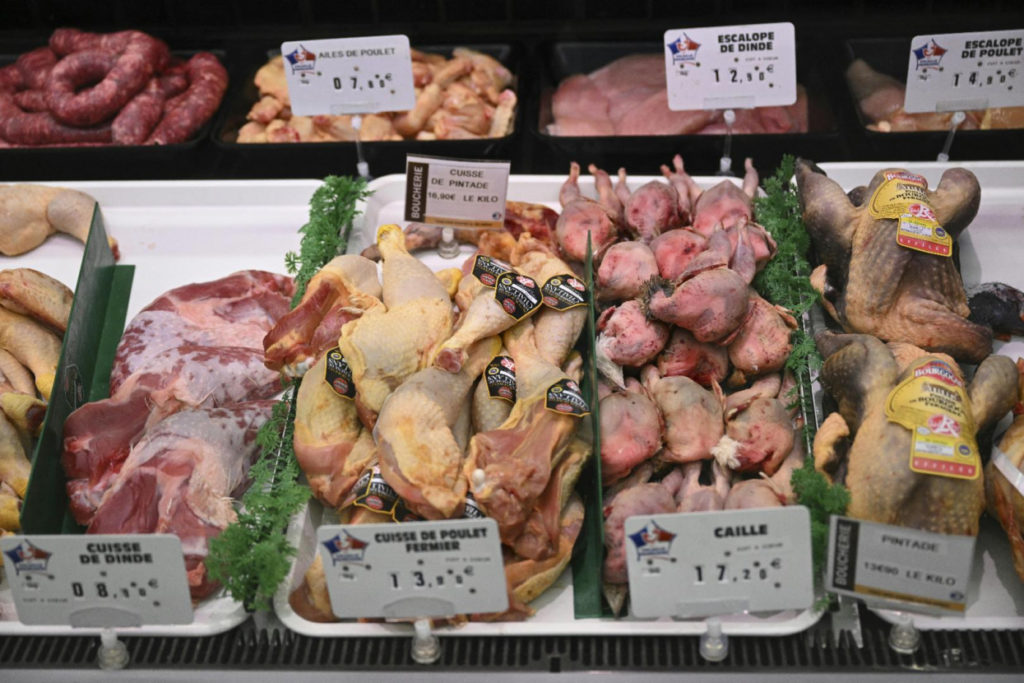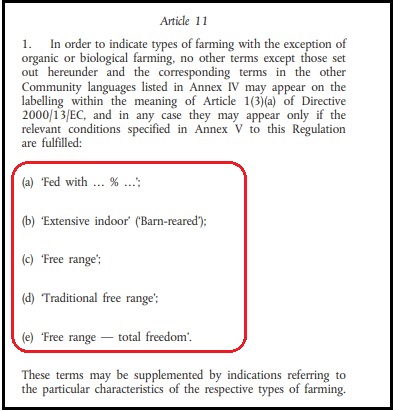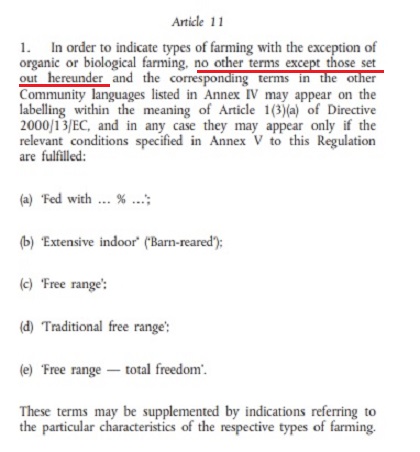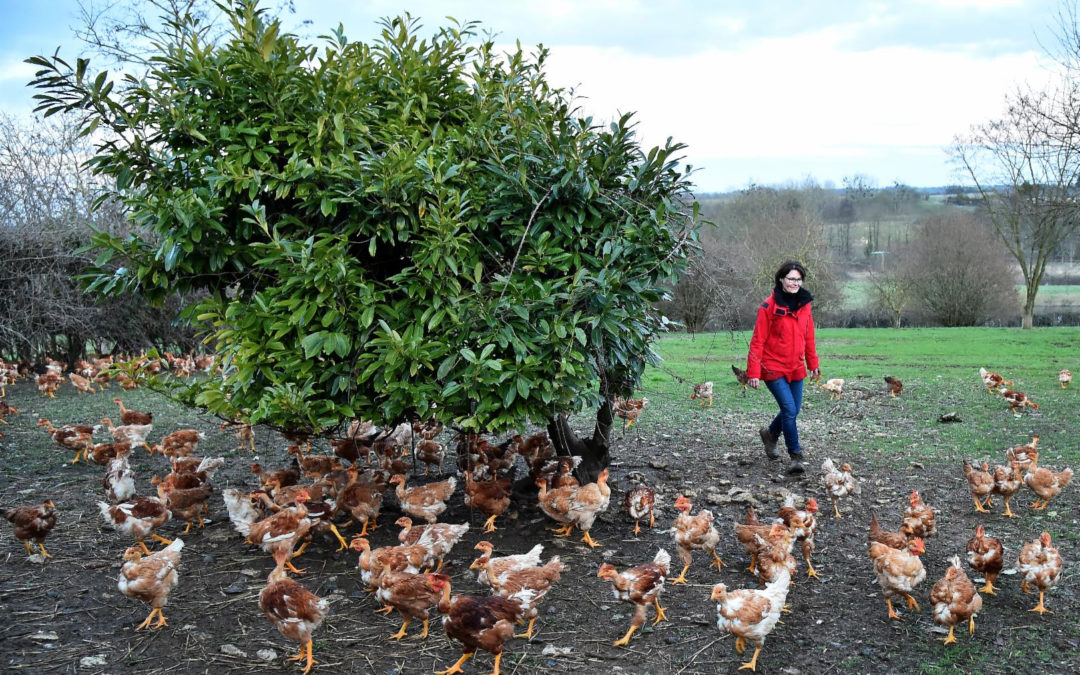Since 2021, a negotiation process has been under way at the European Union level to update poultry marketing standards within the EU as well as production method indications on poultry labels, such as the “traditional free range” designation.
When an initial version of the new EU regulation was made public in January 2023, several online websites and political figures responded, arguing that the changes would spell the end of Label Rouge standards or “abolish mentions of the poultry farming method“, as claimed by The Epoch Times, a website with a history of spreading unsubstantiated theories.
“Good chicken’s over!“, journalist Andre Bercoff claimed on Sud Radio on February 9. “No more labelling: you’ll have a choice between Romanian or Bulgarian industrial chicken, marked as free-range. And Label Rouge is over. That’s Europe for you. We’ll be forced to eat whatever without knowing what we’re consuming.“
The matter also drew a response from the president of the National Rally (RN), Jordan Bardella: in a video posted to Twitter on February 15 and shared nearly 3,000 times, the MEP claimed that the European Union “is threatening the high-quality French poultry sector by wanting to abolish the standards that define the Label Rouge“.
Label Rouge not affected
France’s chicken sector has indeed shared its concerns since January that there would be a “liberalisation” of poultry labelling. In a statement released on January 25, the French poultry industry group Anvol warned of a threat “to the production of traditional free-range poultry and to the truth and clarity of consumer information.“
However, these concerns have at times been misinterpreted, as the Label Rouge itself is not under threat. The various standards and specifications regarding French and European labels — like the Label Rouge or the AOP (Protected Designation of Origin, PDO) of Bresse Poultry — are not affected by the planned European changes.
“These unfounded fears are in fact a matter of mixing up two different things,” said Adina Revol, spokeswoman for the European Commission’s French representation. “First, there’s the issue of quality labels (Label Rouge and AOP in this case, but also IPG (Protected Geographical Indication, PGI) for example). There is absolutely no question of abolishing them, nor of rendering them meaningless,” she told AFP on February 17.
“Then there’s the matter of promoting production methods, and in particular of the mentions that can appear on poultry sold within the European market,” she added.
For their poultry to receive France’s Label Rouge — which was started in 1960 — farmers must fulfil a number of criteria relating to poultry feed, as well as the farming method. Label Rouge chickens are for example birds raised in the traditional free-range method (a minimum of two square metres of outdoor space per chicken) or in total freedom (without coops).
Chicken farmers as a whole also confirm that the Label Rouge is not at stake. “We have never spoken of abolishing Label Rouge standards,” Anvol director Yann Nedelec told AFP on February 17.
Ditto for Gilles Huttepain, president of the Federation of Poultry Industries (FIA), who confirmed that Anvol had “never said that the Commission wanted to abolish the Label Rouge” during a press conference on February 22.

‘Liberalised’ labelling in the first version of the regulation?
Yet, Label Rouge poultry farmers did warn of a “long-term” threat to their farms from what they describe as “unfair competition“.
Since late January, they have been concerned that the regulation currently under discussion will affect the existing rules on what additional criteria farmers can add to their labels to indicate the production method.
Indeed, in addition to pre-existing labels (Label Rouge, AOP…), EU regulation has since 2008 set out a list of five terms that refer to the particular characteristics of the farming method (see below), each based on precise criteria.

(Screenshot taken on February 23, 2023)
A farmer can therefore indicate how the chicken was raised, if he so chooses, as long as it is in accordance with the precise label nomenclature.
Indoor chicken farmers can for example specify that their poultry was raised in an “extensive indoor” system, while Label Rouge farmers can explicitly say that their chicken was raised using the “traditional free range” method or in “total freedom“.
These optional terms are exhaustive: no other description of the farming method can be used on labels of chicken sold in the European Union.
But in late January, French chicken farmers argued that the proposed regulation would de facto abolish the exclusive nature of the nomenclature. According to them, this would allow other farmers to include other — less stringent — terms, which would result in confusing the consumer. Anvol provided as examples potential terms like “Field chicken” and “Open-air chicken”.
According to the French farmers, this would enable, say, German or Dutch farmers to include terms that would enhance their indoor farming methods in the eyes of the consumer. This was notably expressed by Bernard Tauzia, president of the National Union of Poultry Labels of France (Synalaf), during a press conference on February 22.
This would “undermine good consumer information and the development of alternative” poultry production, according to Synalaf.
Anvol, which notably represents Label Rouge chicken farmers, denounced the Commission’s desire to “abolish standards allowing consumers to clearly identify poultry production methods thanks to the five set terms allowed to date” but also its willingness to open the floodgates to a “forest of terms” that could confuse the consumer, as expressed by Gilles Huttepain during a press conference on February 22.
Labelling ‘deregulation’ or the ‘enhancement of other factors linked to animal welfare’?
The first version of the new regulation — the one released in January 2023 — does indeed appear less stringent compared to existing rules: while article 11 of the 2008 regulation made the five terms exclusive, clearly indicating that “no other terms” could appear on the label (below left), this notion of exclusivity no longer appears in article 10 of the initial version of the new regulation (below right).

(Screenshot taken on February 23, 2023)

The National Institute for Origin and Quality (INAO), in charge of labels and appellations in France, also told AFP on February 16 that these changes could have the effect of “relaxing the labelling system by allowing the use of other terms besides the optional reserved terms, which could pose an issue vis-a-vis the limited number of terms currently used on Label Rouge products“. It noted however that the matter was still under discussion.
Questioned on the subject at the senate, Agriculture Minister Marc Fesneau expressed his reservations regarding the regulation proposed in January: “There’s the risk of deceiving consumers, and also the risk that the traditional free-range and Label Rouge sectors will no longer be as esteemed.”
Contacted by AFP, the ministry confirmed on February 24 that this “deregulation of the use of valorising terms for labelling poultry meat which to date had been limited to a closed list of five valorising terms would have allowed a coexistence on the European market of valorising terms defined at the European level with terms not regulated by European rules but using words or notions related to those regulated at the European level“. It also pointed to the risk of “unfair competition” from other poultry in countries whose farming methods are often considered less virtuous by the consumer.
The European Commission addressed these concerns in an article published to the website of its French representation on February 14. It explained that, “the discussions with member state representatives revolve around permitting other terms in addition to the five present since 2008 by allowing farmers to promote other factors related to the poultry production method, notably those involving animal welfare, and by informing the consumer of the contents of the information in a transparent manner.“
“Other additional appellations could thus be worth authorising and that is the subject of discussion in the same vein of informing consumers in a trustworthy manner and protecting farmers who embark on this path,” Adina Revol told AFP on February 16. “Deceiving consumers with ambiguous or vague terms will continue to be absolutely forbidden“.
The Commission had moreover responded to the French farmers that if new terms “were to be proposed by farmers, they would have to be accompanied by precise criteria” and would be subject to regular checks.
A new version of the text published on February 22 that ‘satisfies‘ farmers
The pushback from farmers and the ministry of agriculture appear to have shifted the lines, as the latest version of the future regulation, published on February 22, again mentions the exclusivity of terms, but only regarding outdoor farming.
The new regulation provides in effect that the “only terms that can be used to designate products from livestock raised outdoors” are “free range”, “traditional free range” and “free range — total freedom“, or in large part the same ones as those used by the French Label Rouge.

These modifications appear to have satisfied Label Rouge farmers. During a press conference held by Anvol on February 22, the “compromise” was hailed across the board. During a follow-up with AFP on February 24, Anvol director Yann Nedelec said he was “satisfied with the Commission’s proposal, which protects the valorising terms of traditional free range or free range chicken.“
Like the farmers, the ministry said it wanted to be “careful” regarding a matter that is still under discussion, though it told AFP that it was satisfied with a compromise that “protects and maintains the exclusivity of the use of the ‘free-range’ terms.” “The draft text still needs to pass through several steps before its publication in a couple of weeks.“
15% of French poultry production certified as Label Rouge
The share of chickens raised in either total freedom or in the traditional free-range manner in France is one of Europe’s largest, with 19 percent of poultry raised with access to the outdoors, against just 1 percent in Germany or the Netherlands.
In 2021, 17 percent of France’s poultry production displayed the words “free-range chicken” on their labels — 15 percent of them Label Rouge and 2 percent bio. Hence the great interest in France, with Anvol declaring in its press statement that French farmers were “the most affected by the labelling changes“.
AFP France

- Home
- About AFP
- How we work
- Editorial & Ethical standards
- Fact-Checking Stylebook
- Meet the team
- Training
- Subscribe
- Contact
- Corrections
Copyright AFP 2017-2023. All rights reserved. Users can access and consult this website and use the share features available for personal, private, and non-commercial purposes. Any other use, in particular any reproduction, communication to the public or distribution of the content of this website, in whole or in part, for any other purpose and/or by any other means, without a specific licence agreement signed with AFP, is strictly prohibited. The subject matter depicted or included via links within the Fact Checking content is provided to the extent necessary for correct understanding of the verification of the information concerned. AFP has not obtained any rights from the authors or copyright owners of this third party content and shall incur no liability in this regard. AFP and its logo are registered trademarks.
